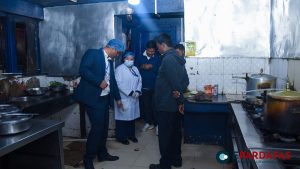
Tuberculosis Still a Global Health Concern

Tuberculosis (TB), an infectious disease caused by bacteria primarily affecting the lungs, continues to be a significant global health threat. Despite being preventable and curable, TB claims millions of lives annually, with concerted efforts required to combat its spread effectively.
According to recent data, approximately 1.3 million people succumbed to TB in 2022, underscoring its status as the second leading infectious killer worldwide, surpassed only by COVID-19. This figure includes 167,000 individuals with HIV, highlighting the intersectionality between these two diseases and the increased vulnerability of those with compromised immune systems.
In 2022, an estimated 10.6 million people worldwide fell ill with TB, emphasizing the pervasive nature of the disease across all countries and age groups. Notably, multidrug-resistant TB (MDR-TB) remains a pressing public health crisis, with only about 40% of affected individuals accessing treatment.
Despite the grim statistics, global efforts have saved an estimated 75 million lives since the turn of the century. The United Nations Sustainable Development Goals (SDGs) aim to eradicate the TB epidemic by 2030, setting ambitious targets for prevention, diagnosis, and treatment.
Symptoms of TB vary, with common signs including prolonged cough, chest pain, weakness, fatigue, weight loss, fever, and night sweats. Prompt medical attention and adherence to treatment regimens are crucial in curbing the spread of the disease.
Preventive measures such as seeking medical care for symptoms, getting tested for TB infection, and practicing good hygiene are vital components of TB control strategies. Additionally, the Bacille Calmette-Guérin (BCG) vaccine is administered in certain countries to prevent TB in infants and children, although its efficacy is limited against lung TB.
Diagnosing TB, particularly drug-resistant strains, remains a challenge, necessitating the use of rapid molecular diagnostic tests recommended by the World Health Organization (WHO). Treatment typically involves a combination of antibiotics taken over several months, with MDR-TB requiring more intensive and costly interventions.
The intersection of TB with other health conditions, such as HIV/AIDS, undernutrition, diabetes, and tobacco use, further complicates efforts to combat the disease. Collaborative approaches that address these underlying factors are essential in reducing TB-related morbidity and mortality.
Investments in TB prevention, diagnosis, treatment, and research are imperative to achieve global targets and mitigate the socioeconomic impact of the disease. While domestic funding constitutes a significant portion of TB expenditures, international support, notably from organizations like the Global Fund to Fight AIDS, Tuberculosis, and Malaria, remains crucial.
Despite progress in recent years, additional resources are needed to accelerate the development of new tools and interventions to combat TB effectively. With sustained commitment and collective action, it is possible to end the TB epidemic and fulfill the vision of a healthier, TB-free world by 2030.
For further information, individuals are encouraged to seek guidance from healthcare professionals and public health authorities regarding TB prevention, diagnosis, and treatment.
This report is based on data from the World Health Organization (WHO) and other relevant sources.












Comments